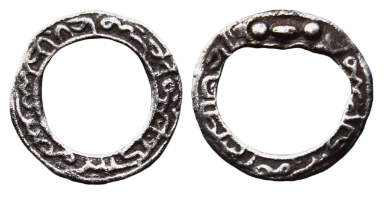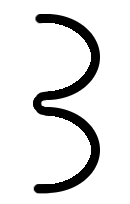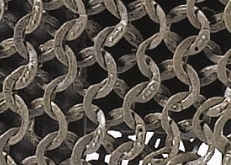| Author |
Message |
Dan Howard

|
 Posted: Sat 06 Apr, 2013 1:45 am Post subject: Posted: Sat 06 Apr, 2013 1:45 am Post subject: |
 |
|
I've never seen triple-riveted links before. Very cool. Would be nice to see the other side. I'm guessing that the rivet is a short length of wire bent into a staple in the shape of the number 3.
Edited to include the link.
 Attachment: 87.24 KB Attachment: 87.24 KB

Last edited by Dan Howard on Sat 06 Apr, 2013 1:11 pm; edited 1 time in total
|
|
  |
 |
|
Len Parker
|
 Posted: Sat 06 Apr, 2013 4:35 am Post subject: Posted: Sat 06 Apr, 2013 4:35 am Post subject: |
 |
|
|
Dan, I was thinking that the middle one is a wedge shaped rivet with a clamp rivet overlapping.
|
|
  |
 |
Dan Howard

|
 Posted: Sat 06 Apr, 2013 12:54 pm Post subject: Posted: Sat 06 Apr, 2013 12:54 pm Post subject: |
 |
|
Is there evidence for wedge-riveting outside of Germany? In any case a wedge-rivet won't look like that. It also makes more sense to do the riveting in one operation with a single peening tool. A staple shaped like this should produce a result very similar to the photo. There is no way to know for certain without seeing the other side of the link.
 Attachment: 1.83 KB Attachment: 1.83 KB

|
|
  |
 |
|
Len Parker
|
 Posted: Sat 06 Apr, 2013 1:29 pm Post subject: Posted: Sat 06 Apr, 2013 1:29 pm Post subject: |
 |
|
|
Looking at it again, I think you might be right. It does have an arched look about it. It doesn't look like the typical wedge rivet.
|
|
  |
 |
|
Mart Shearer
|
 Posted: Sat 06 Apr, 2013 2:56 pm Post subject: Posted: Sat 06 Apr, 2013 2:56 pm Post subject: |
 |
|
Looking inside the neckline might offer a clue, but the mail at the neck is clearly rolled, so we might still be looking at the outside of some sort of hood. If not, the rivet heads appear to be double-sided. Missing rivets are evident at both the bottom split and at the neck split, where only 1 of 3 is missing, leaving a round hole.
ferrum ferro acuitur et homo exacuit faciem amici sui
|
|
  |
 |
Dan Howard

|
 Posted: Sat 06 Apr, 2013 3:25 pm Post subject: Posted: Sat 06 Apr, 2013 3:25 pm Post subject: |
 |
|
|
Kinda looks like three separate rivets on the inside of the neckline. The empty rivet holes support this too.
|
|
  |
 |
|
Mart Shearer
|
 Posted: Sat 06 Apr, 2013 6:37 pm Post subject: Posted: Sat 06 Apr, 2013 6:37 pm Post subject: |
 |
|
A detail shot of some missing rivets from the skirting split:
 Attachment: 43.86 KB Attachment: 43.86 KB

ferrum ferro acuitur et homo exacuit faciem amici sui
|
|
  |
 |
Ahmad Tabari

|
 Posted: Sun 07 Apr, 2013 11:14 pm Post subject: Posted: Sun 07 Apr, 2013 11:14 pm Post subject: |
 |
|
Very cool mail finds. Too bad there aren't any mail shirts from the early Mamluk period.
I would just like to point out something regarding the whole horseman versus footman discussion. I noticed that you have mainly been considering one on one encounters. you should keep in mind that these would have been very rare scenarios. Unless you are mainly thinking about skirmishes, whenever horsemen and infantry met it was formation against formation. And from my understanding of battle accounts and military treatises (keep in mine I am no expert), horsemen would only engage infantry head on under four circumstances.
1- If the horsemen intend to immediately withdraw after delivering the charge
2- The infantrymen are scattered/ and or routing
3- The infantry formation had been softened by archery
4- If the heavy cavalry is confident that the infantry would rout upon initial impact.
I think its very rare for horsemen, even heavily armoured ones to be willing to get bogged down in melee with a solid infantry formations. Of course there are always exceptions but I believe that the norm for cavalry is they either break the infantry upon impact or they withdraw and regroup for another charge.
|
|
  |
 |
|
Jaroslav Kravcak
|
 Posted: Mon 08 Apr, 2013 3:53 am Post subject: Posted: Mon 08 Apr, 2013 3:53 am Post subject: |
 |
|
| Ahmad Tabari wrote: | Very cool mail finds. Too bad there aren't any mail shirts from the early Mamluk period.
I would just like to point out something regarding the whole horseman versus footman discussion. I noticed that you have mainly been considering one on one encounters. you should keep in mind that these would have been very rare scenarios. Unless you are mainly thinking about skirmishes, whenever horsemen and infantry met it was formation against formation. And from my understanding of battle accounts and military treatises (keep in mine I am no expert), horsemen would only engage infantry head on under four circumstances.
1- If the horsemen intend to immediately withdraw after delivering the charge
2- The infantrymen are scattered/ and or routing
3- The infantry formation had been softened by archery
4- If the heavy cavalry is confident that the infantry would rout upon initial impact.
I think its very rare for horsemen, even heavily armoured ones to be willing to get bogged down in melee with a solid infantry formations. Of course there are always exceptions but I believe that the norm for cavalry is they either break the infantry upon impact or they withdraw and regroup for another charge. |
Thats why I stated earlier I aim at individual horsemanship and weapon handling skills, not to ways of cavalry formation engaging dense and nondisordered infantry formation. My idea is, that the summary you gave sums it up nicely, though I think with the exception of withdraw after charge, it also sums up condition under which any force, infantry, or cavalry would ideally attack. (Im yet to see any evidence, that infantry of same quality and even several times their numbers would clearly succeed, if it substituted heavy cavalrys place in some of its worst defeats.)
Nevertheless, one on one in these terms means fighting against disordered enemy as well, to specify. When, by means mentioned above, cohesion and organization of infantry ceases to exist and its every man for himself in chaotic fight , that should theoretically be situation in which cavalry enjoyes superiority. (Second maybe only to cutting down fleeing enemies)
So the question is, would they really be highly effective against scattered enemy fighting in no coordinated manner, so that whole fight is just a series of struggles involving individuals, or very small groups? (If not, then Id say whole use of cavalry would really be only in terms of psychological weapon, useless in most actual fighting.) As far as examples go, id say there is enough evidence to say they were theoretically able to cause disproportionate casualties to enemies in these situations. If yes, then my view is the individual skill, maybe ability to cooperate in small groups was crutial under these circumstances, so I try to find out how they did it.
My motivation is mainly to find out, if weapon handling from horseback and horsemanship in war on individual level was more sophisticated and involved more, than just riding by and hacking at things, or relying on hugely superior weapon reach, or purely on ability to scare someone into not resisting. Battles were rare generally and any horseman seeing much fighting would only be involved in few big battles in his lifetime, while skirmishing/raiding/whatever else small war involves would be his daily bread.
Id like to find out, if it is better to stay with training foot combat, which is much less costly, or if it would be worth to invest time and effort into horse, horsemanship and maybe horse training without being dissappointed after several years of training, that all I tryed to train is easily countered by someone on foot and I have big problems defending against him myself, while on horse, no matter what I try. 
|
|
   |
 |
Luka Borscak

|
 Posted: Mon 08 Apr, 2013 1:00 pm Post subject: Posted: Mon 08 Apr, 2013 1:00 pm Post subject: |
 |
|
Strict one on one fighting between horseman and footman shouldn't happen in a battle when infantry is disorganized and cavalry wants to take advantage of that. Cavalry should ride relatively fast among the disorganized and probably frightened footman, bumping into them, knocking them down, particular horseman should not concentrate on one particular footman unless he is a "light" target, facing away from them, is unable for some reason to defend, is concentrated on another horseman, etc...Psychological impact of cavalry is much greater if cavalry maintains chaos than if they concentrate each on "his own" infantryman and fight duels with footmen.
Also, using a spear/lance gives cavalry great advantage. Couched lance has greater reach than footman's spear because it can be held closer the butt and horse still gives you enough agility, footman has to hold spear closer to the middle if he wants to wield it with agility against a horseman.
|
|
  |
 |
Ahmad Tabari

|
 Posted: Mon 08 Apr, 2013 7:10 pm Post subject: Posted: Mon 08 Apr, 2013 7:10 pm Post subject: |
 |
|
| Quote: | | Thats why I stated earlier I aim at individual horsemanship and weapon handling skills, not to ways of cavalry formation engaging dense and nondisordered infantry formation. |
Judging a contest between a single horseman and an infantryman is very tricky. On one hand the horseman (as Lafayette mentioned) has the advantage of initiative. He decides when, how and at what speed to engage the infantryman. And he can of course either use the horse's strength to run down the infantryman or use the horse's maneuverability to get passed the infantryman's defense and deliver a blow from the back. But by the same token, the infantryman can benefit form the horse's size (big target). And he can equally benefit from his stable position. One of the things that can truly tip the balance in the favour of the cavalryman is horse armour.
| Quote: | | Nevertheless, one on one in these terms means fighting against disordered enemy as well, to specify. When, by means mentioned above, cohesion and organization of infantry ceases to exist and its every man for himself in chaotic fight , that should theoretically be situation in which cavalry enjoyes superiority. (Second maybe only to cutting down fleeing enemies) |
Yes in such a situation, cavalry will certainly devastate infantry because the latter no longer have their rear and flanks secured (i.e. an ideal situation for cavalry).
| Quote: | | So the question is, would they really be highly effective against scattered enemy fighting in no coordinated manner, so that whole fight is just a series of struggles involving individuals, or very small groups? (If not, then Id say whole use of cavalry would really be only in terms of psychological weapon, useless in most actual fighting. |
Conventional military thought would say yes. Without having their rear and flanks secured, small scattered groups of infantry would most certainly be wiped out by cavalry.
| Quote: | Id like to find out, if it is better to stay with training foot combat, which is much less costly, or if it would be worth to invest time and effort into horse, horsemanship and maybe horse training without being dissappointed after several years of training, that all I tryed to train is easily countered by someone on foot and I have big problems defending against him myself, while on horse, no matter what I try.  |
I think the key to staying ahead and not getting disappointed is maintaining versatility. Infantrymen will always find ways to give proud horsemen a nasty and unexpected surprise. But cavalry in turn must also find ways to counter the infantry's strategy. Had they failed to do so they would not have remained the dominant force on the battlefields of Eurasia and North Africa well into the age of gunpowder. Remember, cavalry units such as the Polish Hussars were kicking infantry butts well into the 17th century 
|
|
  |
 |
|
Lafayette C Curtis
|
 Posted: Wed 17 Apr, 2013 6:23 am Post subject: Posted: Wed 17 Apr, 2013 6:23 am Post subject: |
 |
|
| Jaroslav Kravcak wrote: | Id like to find out, if it is better to stay with training foot combat, which is much less costly, or if it would be worth to invest time and effort into horse, horsemanship and maybe horse training without being dissappointed after several years of training, that all I tryed to train is easily countered by someone on foot and I have big problems defending against him myself, while on horse, no matter what I try.  |
Not trying to be offensive here, but that's a silly question.  If you're interested in it, then it IS worth the investment. Whether you'll be able to get good enough at it before the zombie apocalypse comes is an entirely different (and, for the moment, irrelevant) question. If you're interested in it, then it IS worth the investment. Whether you'll be able to get good enough at it before the zombie apocalypse comes is an entirely different (and, for the moment, irrelevant) question.
In other words, you can't really control all the circumstances in war (including whether you'll ever be involved in a real one or not). If you want to prepare yourself, just go ahead and train. The worst that can happen is you get a bit of fun before you die. 
|
|
  |
 |
Bennison N

|
 Posted: Wed 17 Apr, 2013 1:39 pm Post subject: Posted: Wed 17 Apr, 2013 1:39 pm Post subject: |
 |
|
Seriously, if you have real trouble fighting a man on foot while on a horse, you're not doing it properly.
"Never give a sword to a man who can't dance" - Confucius
अजयखड्गधारी
|
|
  |
 |
Tibor Szebenyi

|
 Posted: Thu 04 Jul, 2013 2:40 am Post subject: Posted: Thu 04 Jul, 2013 2:40 am Post subject: |
 |
|
We cannot really decide theese questions based on real life experiences, because it is far from real battle. As Lafayette already wrote, today's warriors don't want to hurt the horse, and on the other hand today's cavalry doesn't want to smash friends into the ground.
Instead of thinking about it too much, install the superb game Mount and Blade! I am not joking, try it! It is an excellent medieval battle simulator, in which both the warriors and the horses have hit points, so it really makes sense to always push the forward button while mounted. 
mamluk.webnode.hu
|
|
   |
 |
|
|
You cannot post new topics in this forum
You cannot reply to topics in this forum
You cannot edit your posts in this forum
You cannot delete your posts in this forum
You cannot vote in polls in this forum
You cannot attach files in this forum
You can download files in this forum
|
All contents © Copyright 2003-2024 myArmoury.com — All rights reserved
Discussion forums powered by phpBB © The phpBB Group
Switch to the Basic Low-bandwidth Version of the forum
|

